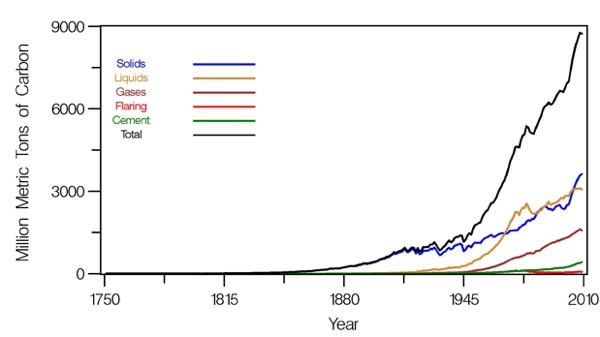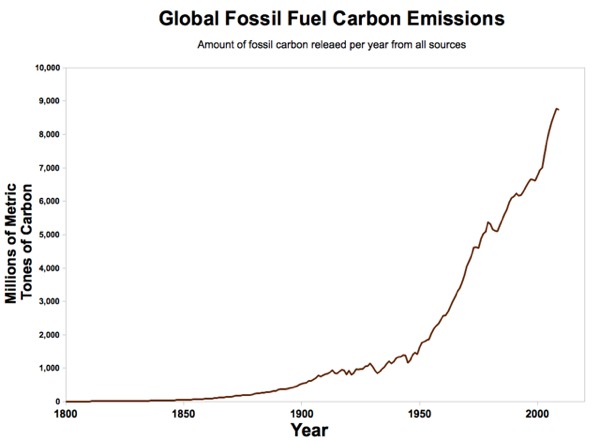Here are two graphs that show the amount of carbon released into the atmosphere, mainly as CO2 and mainly form the burning of fossil fuels, per year, from various sources for a long span of time. Both graphs are based on the same data set. the first graph was created by the Carbon Dioxide Information Analysis Center and shows the breakdown between different sources of carbon. The second graph, which I made, simply shows the total, and over a shorter time span to make it easier to use for other purposes.
More like this
Naming Some Special Graphs
One kind of graph problem that's extremely widely used in computer science is called graph coloring. There's two versions of it, *vertex coloring*, and *face coloring*.
Let's talk a bit about graphs, being a tad more formal about them.


In a perfect world, wouldn't there be no rise in atmospheric carbon because the increased availability of carbon would be balanced by a response of increased photosynthesis? Why are the plants allowing this to happen? Does it have anything to do with deforestation, desertification, row crop agriculture, and pollution of the oceans?
Jim, why would you think plants are capable of scaling their biomass like that? Look around, where would all that extra plant biomass fit?
There are a couple of reasons. One is that cells do not scale activity along external gradients like that. They tend to optimize rather than maximize. For plant cells to make use of extra CO2 there would have to be some cost paid in advance in the structure of the system, just in case more CO2 came along. Now, if we could resurrect plants from the period during the Cretaceous when there was more CO2 in the atmosphere, maybe they would make use of it!
Another reason seems to be that other sources of stress keep plants from moving their productivity towards a higher level, including too-high levels of ozone in the atmosphere and possibly (and related) pathogens that are much more common than they probably should be, which may be hobbling plant productivity for many species.
Back in the late 80s or 90s people were working with CO2 tunnels, to create high or at least controlled gas conditions initially for the purpose of altering stable isotopic composition of the atmosphere (and water) to try to figure out what stable isotopes were doing in tissues. Part of that involved increasing CO2 rates in order to speed up the experiments, as well as to see what a CO2 rich atmosphere would do. It was at the time a bit surprising to some (but not all) that increasing CO2 increased plant growth a little, but not much, and to a varying degree depending on species.
Plant growth & reproduction are limited by several resources and conditions, not just CO2 availability. Assuming non-dought conditions, in lots of ecosystems the first limit is nitrogren availability - this is why nitrogen fertilizers are such a big deal, they release crop plants from that limit, allowing them to grow to their potential until they hit the next limit. The next limit is sometimes phosphorus, or sometimes something other than a direct resource such as temperature (either mean, or maximum or minimum event), or competition (intra- or interspecific), or predation (think insect pests, for example). Carbon dioxide availability as a limit doesn't show up until pretty much every other limiting factor has been taken care of.
You could theoretically sequester carbon from the atmosphere by removing multiple limits from plant populations, but I doubt the cost/benefit analysis works out in most cases - making nitrogen fertilizer famously requires large inputs of energy, meaning electricity, meaning digging carbon up and lighting it on fire. This was, however, the underlying theory for those ideas about fertilizing the ocean with iron to remove that limit from planktonic algae (terrestrial plants are rarely iron-limited, because the mineral fraction of most soils contains lots and lots of iron oxides).
http://www.hydroponics.net/learn/co2_calculator.asp
If you want to go into the commercial greenhouse business, you might find this useful. i have visited commercial greenhouses which had blocks of dry ice lying around outgassing. But what do they know?
When land plants take up CO2 through their stomata, they lose water at the same time. So, with increased CO2 the plants can close stomata quicker and lose less water. I have read that tree ring reflection of climate is no longer reliable for the last few years because the growth does not reflect water availability to the extent we have been used to.
I have taught limnology. It is common for lakes to shutdown photosynthesis early in the afternoon because of reduction in CO2 content in the water. Some plants, Elodea for example, can extract CO2 from bicarbonate ions and will do so when CO2 levels drop. You will see them with a white dusting of carbonates.
Liebig's law of the minimum still works, and sometimes the minimum is CO2.
Another Tasmanian. Cool. I don't think the limiting stuff is completely true though. Assoc. Prof. Mark Hovenden's work at UTas shows that merely increasing CO2 had some amount of effect on growth of grasses (See TasFACE). However the CO2 fertilisation effect is much smaller than the amount of CO2 we're putting out though.
I'm not surprised that CO2 additions can increase plant growth, and I'm not disputing its importance, particularly in some ecosystems such as lakes. In a hydroponic greenhouse, presumably the other limits are well taken care of by precise regulation of the amount of available N, P, S, Ca, Fe, etc. in the hydroponic solutions. Blocks of dry ice sounds like a pretty good way to raise the CO2 concentration in the local atmosphere, plus I'm sure it looks cool.
The "but what do they know" comment is both unnecessarily aggressive and not particularly relevant. This idea that somebody doing something for business or professional reasons must be doing exactly the right thing is not always true or useful - people do lots of things in lots of contexts that are of little or no use to the task at hand, and may be based on myth or simply "we've always done it this way". Just because somebody, somewhere is doing a thing, doesn't mean that thing is doing what they think it's doing.
increased CO2 can have a huge impact on plants especially when growing indoors. thats why so many growers supplement their growing areas with CO2 controllers like these...
http://www.greenerhydroponics.com/Setting-Up-A-Titan-Controls-CO2-Regul…
im sure there has been a significant increase in CO2 output in areas like colorado since the legalization of cannabis!